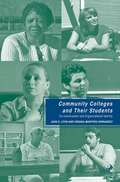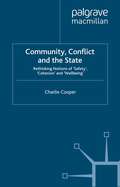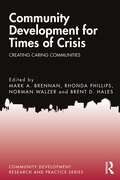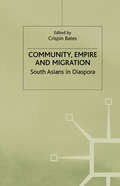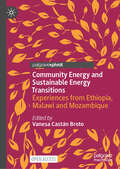- Table View
- List View
Community College Students in Hong Kong: Class Inequality in Higher Education (Palgrave Studies on Chinese Education in a Global Perspective)
by Yi-Lee WongThis book presents a comprehensive account of the educational experiences of community college students in Hong Kong, analyzed through a theoretical lens that intersects sociological theories of inequality, including Bourdieu's concept of cultural capital. The student narratives featured in this book reveal the interweaving personal, academic, and professional considerations and challenges affecting their individual choices in the pursuit of higher education. Chapters also reveal why, despite the relative expansion of educational opportunities, the class gap in higher education persists.
Community Colleges and Their Students: Co-construction and Organizational Identity
by J. Levin Virginia Montero-HernandezThis book employs a socio-cultural approach to study the organizational dynamics and experiences of self-formation that shape community college life. The authors use case studies to analyze both the symbolic dimension and practices that enable the production of educational experiences in seven community colleges across the U.S. Levin and Montero-Hernandez explain the construction of organizational identity and student development as a result of the connection between institutional forces and individual agency. This work emphasizes the forms and conditions of interaction among college personnel, students, and external groups that were enacted to respond to the demands and opportunities in both participants local and larger contexts. The authors acknowledge both the collective and individual efforts of community college personnel to create caring community colleges that support nontraditional students.
Community, Conflict and the State: Rethinking Notions of 'Safety', 'Cohesion' and 'Wellbeing'
by C. CooperCommunity safety is a narrowly defined concept that allows states to ignore arguably more serious threats caused by pro-market policies and the actions of major corporations. This book redresses the idea of what constitutes a social harm and outlines a new policy agenda.
Community, Crime and Disorder: Safety and Regeneration in Urban Neighbourhoods
by L. HancockThis book fills a number of gaps in the 'community and crime' literature, makes important theoretical contributions, and is based on original research. Questions explored include: How do changes in the urban environment impact upon local (high crime) communities? How do changes in housing provision and consumption influence crime patterning? Can current community safety and urban policies address the needs of high crime, mixed tenure, inner-city areas? And how do community groups respond to neighbourhood change, crime and disorder?
Community Development And Family Planning: An Egyptian Experiment
by J. Mayone StycosProgram evaluation is not among the most popular of exercises, since it carries risks for all associated with it. Because every important program has friends and enemies anxious for its prosperity or demise, the investigators and their findings will normally be attacked from at least one side and not infrequently from both. But this is an occupational hazard, dutifully accepted by its practitioners; for some it even adds a zestful touch of danger. However, the program's sponsors and its participants require an unusual degree of courage, since negative or indifferent results are not infrequently used to impugn their wisdom or dedication. We applaud the courage of all those who, in the interest of improving policies and programs to further their clients' well-being, assumed the risks of introducing scientific program evaluation: Primary credit goes to the sponsor of the current research, the United Nations Fund for Population Activities (UNFPA), in particular the Mediterranean and Middle East Branch and its chief, Roushdi El Henedi. Special thanks go to Dr. Habib Siddiqui for his stimulus in launching the study. His efforts were followed by those of M.A. Abu-Nuwar, whose bureaucratic and diplomatic skills were much appreciated, and Sylvia Rhodes, who was of assistance near the close of the project. UNFPA staff in Egypt, in particular Hamed Fahmy, were most helpful in the field. Needless to say, neither these individuals nor the UNFPA necessarily agree with the conclusions reached in this book.
Community Development And Family Planning: An Egyptian Experiment
by J. Mayone StycosProgram evaluation is not among the most popular of exercises, since it carries risks for all associated with it. Because every important program has friends and enemies anxious for its prosperity or demise, the investigators and their findings will normally be attacked from at least one side and not infrequently from both. But this is an occupational hazard, dutifully accepted by its practitioners; for some it even adds a zestful touch of danger. However, the program's sponsors and its participants require an unusual degree of courage, since negative or indifferent results are not infrequently used to impugn their wisdom or dedication. We applaud the courage of all those who, in the interest of improving policies and programs to further their clients' well-being, assumed the risks of introducing scientific program evaluation: Primary credit goes to the sponsor of the current research, the United Nations Fund for Population Activities (UNFPA), in particular the Mediterranean and Middle East Branch and its chief, Roushdi El Henedi. Special thanks go to Dr. Habib Siddiqui for his stimulus in launching the study. His efforts were followed by those of M.A. Abu-Nuwar, whose bureaucratic and diplomatic skills were much appreciated, and Sylvia Rhodes, who was of assistance near the close of the project. UNFPA staff in Egypt, in particular Hamed Fahmy, were most helpful in the field. Needless to say, neither these individuals nor the UNFPA necessarily agree with the conclusions reached in this book.
Community Development and Schools: Conflict, Power and Promise (ISSN)
by Mildred E. Warner Xue Zhang Jason ReeceThis book lays out the promise and potential of schools as community-building institutions. It explores the challenges faced in incorporating schools into broader community development policy, and also recognizes the changing demographics of schools and their need to integrate with economic development policy in order to promote broader community development.The book includes chapters on tax abatements and economic development policy impacts on schools, new approaches to school building renovation, the potential and reach of shared services between communities and schools, and the impact of school-based health centers. It also offers a theory to integrate schools into community development. Key elements include shared power between communities and schools, greater transparency in economic development policy, collaboration across the broad range of community actors, and engagement of diverse voices. These elements build a greater sense of belonging across generations and class and racial divides.Creative democracy can broaden both school and community development agendas and build a culture of health. This book will help community development and school leaders recognize and pursue the promise of schools as critical community development actors.The Open Access version of this book, available at http://www.taylorfrancis.com, has been made available under a Creative Commons Attribution-Non Commercial (CC-BY-NC) 4.0 license.
Community Development and Schools: Conflict, Power and Promise (ISSN)
by Mildred E. Warner Xue Zhang Jason ReeceThis book lays out the promise and potential of schools as community-building institutions. It explores the challenges faced in incorporating schools into broader community development policy, and also recognizes the changing demographics of schools and their need to integrate with economic development policy in order to promote broader community development.The book includes chapters on tax abatements and economic development policy impacts on schools, new approaches to school building renovation, the potential and reach of shared services between communities and schools, and the impact of school-based health centers. It also offers a theory to integrate schools into community development. Key elements include shared power between communities and schools, greater transparency in economic development policy, collaboration across the broad range of community actors, and engagement of diverse voices. These elements build a greater sense of belonging across generations and class and racial divides.Creative democracy can broaden both school and community development agendas and build a culture of health. This book will help community development and school leaders recognize and pursue the promise of schools as critical community development actors.The Open Access version of this book, available at http://www.taylorfrancis.com, has been made available under a Creative Commons Attribution-Non Commercial (CC-BY-NC) 4.0 license.
Community Development for Times of Crisis: Creating Caring Communities (Community Development Research and Practice Series)
by Mark A. BrennanThis book explores the intersection of community development and local capacity building as a basis for effective disaster mitigation and the alleviation of suffering in times of crisis. Beginning with the Community Development section, the process, context, and methods for community, engagement, and development can be viewed from different structural and logical approaches. This section explores some of the more relevant historical arguments, as well as more contemporary examinations. The second section looks at Critical Human and Community Considerations and sheds light on some of the key concepts that are often overlooked (poverty, race, inequality, social justice, mental health, social division) when framing community responses to disaster. The third section focuses on Fundamental Elements of Caring Communities. This section explores the importance, practical, and measurable impacts of social support, empathy, inclusion, and conflict resolution in creating effective and caring community responses. Finally, the last section focuses on practice and brings together research and theory into applied programming, examples, and evidence from on-the-ground efforts to establish caring communities that respond to local needs in times of crisis and beyond. By addressing these objectives, this book provides a more complete understanding of the essential role that community can play in disaster mitigation. Doing this will provide a better focus for ongoing research endeavors, and program and policy initiatives at the community level that seek to prepare for, respond to, and recover from natural and other disasters. As a result, this book contributes to wider and more sustainable development of our communities beyond disasters, while furthering dialog among community scholars and practitioners.
Community Development for Times of Crisis: Creating Caring Communities (Community Development Research and Practice Series)
by Mark A. Brennan Rhonda Phillips Norman Walzer Brent D. HalesThis book explores the intersection of community development and local capacity building as a basis for effective disaster mitigation and the alleviation of suffering in times of crisis. Beginning with the Community Development section, the process, context, and methods for community, engagement, and development can be viewed from different structural and logical approaches. This section explores some of the more relevant historical arguments, as well as more contemporary examinations. The second section looks at Critical Human and Community Considerations and sheds light on some of the key concepts that are often overlooked (poverty, race, inequality, social justice, mental health, social division) when framing community responses to disaster. The third section focuses on Fundamental Elements of Caring Communities. This section explores the importance, practical, and measurable impacts of social support, empathy, inclusion, and conflict resolution in creating effective and caring community responses. Finally, the last section focuses on practice and brings together research and theory into applied programming, examples, and evidence from on-the-ground efforts to establish caring communities that respond to local needs in times of crisis and beyond. By addressing these objectives, this book provides a more complete understanding of the essential role that community can play in disaster mitigation. Doing this will provide a better focus for ongoing research endeavors, and program and policy initiatives at the community level that seek to prepare for, respond to, and recover from natural and other disasters. As a result, this book contributes to wider and more sustainable development of our communities beyond disasters, while furthering dialog among community scholars and practitioners.
Community Development in an Uncertain World: Vision, Analysis and Practice (PDF)
by Jim IfeIn Community Development in an Uncertain World, Jim Ife draws on the principles of social justice, ecological responsibility and post-Enlightenment and Indigenous perspectives to advance new holistic approaches to community development. The book explores the concept of community development on a local and international scale in the context of globalisation and postcolonial theory. Students will gain the essential skills and practical understanding required to navigate the existing managerial environment and cultivate new community practices. This new edition incorporates current research into community development and includes important new work on 'alternative visions' for a sustainable and just future. It introduces the foundational theories of community development and explains their importance in shaping solutions to uniquely modern issues. Readers are encouraged to critically engage with the material through the accompanying discussion questions. Written in an accessible, engaging style, this text is an essential resource for students and professionals in the human services.
Community Development on the North Atlantic Margin: Selected Contributions to the Fifteenth International Seminar on Marginal Regions (Routledge Revivals)
by John Hutson Reginald ByronThis title was first published in 2001. Isolated communities, dependent upon fishing, farming and forestry, which are scattered around the North Atlantic coast, have shared a disastrous decline during the last decade. These communities are in the peripheries of advanced industrial nation-states, such as Canada and supra-national alliances, such as the European Community, yet despite this, there are no easy solutions to the development of these regions. This volume argues that the productive assets of these regions, and how they can be used to sustain household incomes, need to be better understood. The assets need to be converted into products and services and they need to be marketed profitably. The diminshing flow of young people who leave these areas to obtain higher education and who do not return must be turned around and efforts must be concentrated on the creation or strengthening of economic conditions which satisfy the younger generation's employment aspirations, consumer requirements and social needs.
Community Development on the North Atlantic Margin: Selected Contributions to the Fifteenth International Seminar on Marginal Regions (Routledge Revivals)
by Reginald Byron and John HutsonThis title was first published in 2001. Isolated communities, dependent upon fishing, farming and forestry, which are scattered around the North Atlantic coast, have shared a disastrous decline during the last decade. These communities are in the peripheries of advanced industrial nation-states, such as Canada and supra-national alliances, such as the European Community, yet despite this, there are no easy solutions to the development of these regions. This volume argues that the productive assets of these regions, and how they can be used to sustain household incomes, need to be better understood. The assets need to be converted into products and services and they need to be marketed profitably. The diminshing flow of young people who leave these areas to obtain higher education and who do not return must be turned around and efforts must be concentrated on the creation or strengthening of economic conditions which satisfy the younger generation's employment aspirations, consumer requirements and social needs.
The Community Development Reader: History, Themes And Issues (PDF)
by Gary Craig Marjorie Mayo Keith Popple Mae Shaw Marilyn TaylorCommunity development emerged as a recognisable occupational activity in the United Kingdom in the 1950s. Since then, whilst struggling to remain true to its basic values it has often been manipulated to serve differing policy and political purposes. This unique Reader traces its changing fortunes through a selection of readings from key writers. It will be invaluable to those pursuing community development careers, for activists, and for all those teaching, training and practising community development.
The Community Development Reader
by James DeFilippis Susan SaegertThe Community Development Reader is the first comprehensive reader in the past thirty years that brings together practice, theory and critique concerning communities as sites of social change. With chapters written by some of the leading scholars and practitioners in the field, the book presents a diverse set of perspectives on community development. These selections inform the reader about established and emerging community development institutions and practices as well as the main debates in the field. The second edition is significantly updated and expanded to include a section on globalization as well as new chapters on the foreclosure crisis, and emerging forms of community .
The Community Development Reader
by James DeFilippis Susan SaegertThe Community Development Reader is the first comprehensive reader in the past thirty years that brings together practice, theory and critique concerning communities as sites of social change. With chapters written by some of the leading scholars and practitioners in the field, the book presents a diverse set of perspectives on community development. These selections inform the reader about established and emerging community development institutions and practices as well as the main debates in the field. The second edition is significantly updated and expanded to include a section on globalization as well as new chapters on the foreclosure crisis, and emerging forms of community .
Community Development, Social Action and Social Planning 6e: A Practical Guide
by Alan Twelvetrees Russell ToddThe sixth, fully updated edition of this bestselling guide links the theory and practice of community work in an insightful and relatable read for students and practitioners alike. With an accessible style, experienced author Alan Twelvetrees sets out the realities of practice in everyday community development (CD) work. With a much-expanded section on specialist community work, the guide also features brand new sections on work in health, housing, with children, young people and those with disabilities and the changing role of IT, particularly since the COVID-19 pandemic. This edition features: • clear ‘how to’ guides for a variety of CD-related practice; • case studies; • end of chapter discussion points; • signposts to digital resources; • glossary. This classic text provides a comprehensive overview of the knowledge required to work in community practice in the UK and is essential for anyone studying or working in the field.
Community Development, Social Action and Social Planning 6e: A Practical Guide
by Alan Twelvetrees Russell ToddThe sixth, fully updated edition of this bestselling guide links the theory and practice of community work in an insightful and relatable read for students and practitioners alike. With an accessible style, experienced author Alan Twelvetrees sets out the realities of practice in everyday community development (CD) work. With a much-expanded section on specialist community work, the guide also features brand new sections on work in health, housing, with children, young people and those with disabilities and the changing role of IT, particularly since the COVID-19 pandemic. This edition features: • clear ‘how to’ guides for a variety of CD-related practice; • case studies; • end of chapter discussion points; • signposts to digital resources; • glossary. This classic text provides a comprehensive overview of the knowledge required to work in community practice in the UK and is essential for anyone studying or working in the field.
Community Disaster Vulnerability: Theory, Research, and Practice
by Michael J. Zakour David F. GillespieDisaster vulnerability is rapidly increasing on a global scale, particularly for those populations which are the historical clients of the social work profession. These populations include the very young and very old, the poor, ethnic and racial minorities, and those with physical or mental disabilities. Social workers are increasingly providing services in disasters during response and recovery periods, and are using community interventions to reduce disaster vulnerability. There is a need for a cogent theory of vulnerability and research that addresses improved community disaster practice and community resilience. Community Disaster Vulnerability and Resilience provides a unifying theoretical framework backed by research which can be translated into knowledge for effective practice in disasters.
Community, Economy and COVID-19: Lessons from Multi-Country Analyses of a Global Pandemic (Community Quality-of-Life and Well-Being)
by Clifford J. Shultz II Don R. Rahtz M. Joseph SirgyThis volume explores the impact of the COVID-19 pandemic on the health, safety, and socioeconomic well-being of community residents of selected countries around the world. It is built on an overarching framework of studying community well-being, applied here to the analyses of one of the most significant crises of our time. Most important are the lessons learned from the experiences in these countries – including insights and recommendations on how to mitigate future pandemics. Building on years of research, each chapter is written by an accomplished scholar with interests and expertise on various assessments of community well-being development in the country of study. The authors share cases and analyses, and highlight failures and successes; they offer sound policy recommendations on how to restore the health, safety, and multidimensional wellness of community residents, and how to decrease the likelihood and impact of future crises. Some of the policy recommendations in this multi-country compendium can be used to assist crisis prevention and recovery, beyond pandemics. The volume shows how the lessons learned and shared from community responses to the pandemic can provide critical and useful policy insights to shape best practices in mitigating other disasters like hurricanes, floods, earthquakes, tornadoes, wars, riots, acts of domestic and international terrorism, weapons of mass destruction and industrial accidents. This is a must-read for researchers across the social sciences, health sciences, and management studies, and for government and non-government professionals involved in community health and well-being.
Community Education and the Western World
by Angelika Kruger Cyril PosterFirst published in 1990. Routledge is an imprint of Taylor & Francis, an informa company.
Community Education and the Western World
by Cyril Poster Angelika KrügerFirst published in 1990. Routledge is an imprint of Taylor & Francis, an informa company.
Community Eldercare Ecology in China
by Lin Chen Minzhi YeInformed by the social-ecological framework, this book focuses on the development of Home and Community Based Services (HCBS) in urban China. Bringing a timely discussion around HCBS development in Shanghai, it presents an interplay of formal caregiving relationships, evolving caregiving culture, and the trajectory of long-term care in China. Drawing on surveys, in-depth interviews, and government archives, this book explores the emergence of one of the most developed HCBS programs in Shanghai, its development over the past decade, its administration and services, resource allocation, staff members’ work experiences, older adults’ service experiences, as well as service evaluation and improvements. Offering fresh insight into new forms of caregiving in community settings, and shaping a new discourse on caregiving policy, this book is a key read for both students and practitioners in the fields of long-term care, gerontology, geriatrics, health care, and health policy.
Community, Empire and Migration: South Asians in Diaspora
by Crispin BatesSouth Asians in Diaspora is a collection of essays concerning the history, politics, and anthropology of migration in India, Pakistan, and Sri Lanka, as well as in the numerous overseas locations, such as Fiji, Africa, the Caribbean and USA, where South Asians migrated in the colonial period and after. It addresses the connections between migration, problems of identity and ethnic conflict from a comparative perspective, and highlights the role of shared colonial experiences in providing 'communal' solidarities and discord.
Community Energy and Sustainable Energy Transitions: Experiences from Ethiopia, Malawi and Mozambique
by Vanesa Castán BrotoThis open access book engages with the difficulties of delivering community energy in practice, building on practical experiences in Ethiopia, Malawi, and Mozambique. In these countries, where many people lack access to electricity, community energy is an alternative to advance universal energy access. This book argues that, besides providing access, community energy is essential for achieving justice and resilience in sustainable energy transitions. Community energy combines off-grid infrastructures with innovative forms of governance to incorporate the perspectives of beneficiaries in the generation and distribution of electricity. Community energy has multiple benefits for communities, such as facilitating the adoption of renewable technologies, providing energy access where it is lacking, and building resilience. They also offer societal benefits beyond beneficiary communities, such as providing additional capacity to existing grids, delivering off-grid services where the grid is absent, and bridging on-grid and off-grid systems. Despite its promises, however, the adoption of community energy has been slow. This book presents a feminist-informed perspective on community energy to advance energy justice that puts disadvantaged communities at the centre of sustainable energy transitions. It also explores the room for manoeuvre within existing regulatory systems, supply chains, and delivery systems to facilitate its development. By engaging with existing experiences in community energy, the book demonstrates the potential of communities to gain control over their energy needs and resources and argues for the need to develop a wide range of transdisciplinary skills among policymakers, technicians and communities to deliver a just energy transition.

